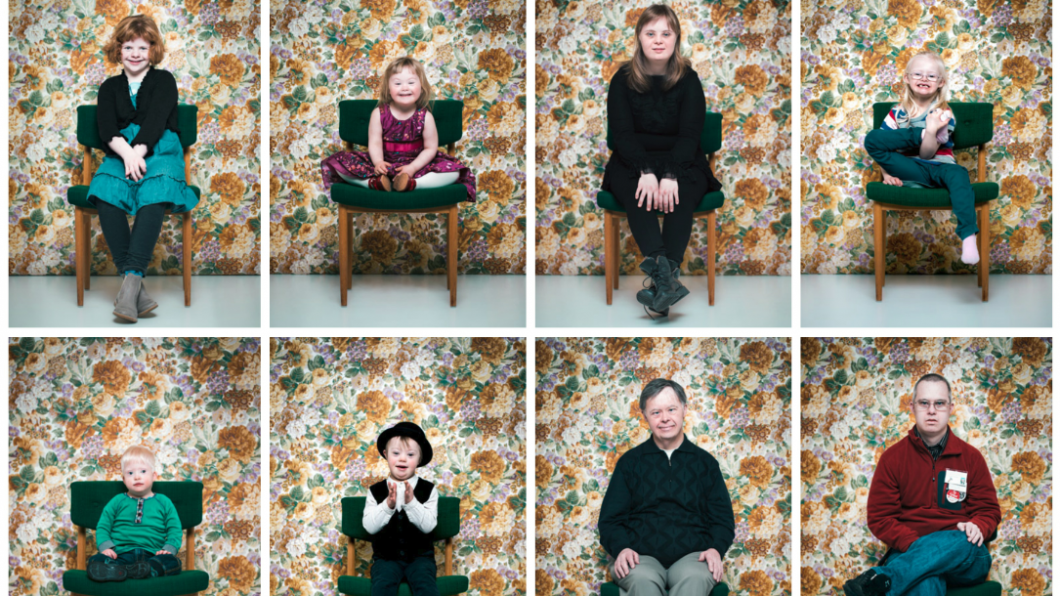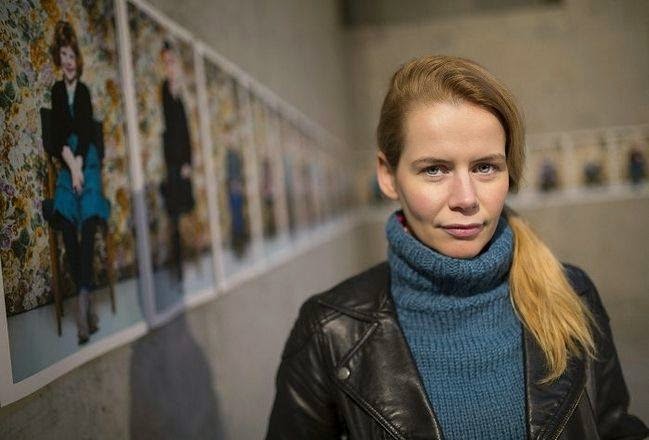
Who, and what, is perfect?
Icelandic photographer Sigga Ella created a series of portraits of children and adults with Down syndrome to question whether a future without genetic diversity is desirable. Her exhibit First and foremost I am has been shown across Iceland and is moving to the Warsaw Festival of Art Photography in Poland next month. Please click on the photo above to see it in full. We interviewed Sigga.
BLOOM: What did you hope to convey in your portraits?
Sigga Ella: To see the beauty of mankind we should celebrate the diversity. The reason I did this project was because of [a] radio interview I heard. They were discussing the ethical questions we now face—that we can choose who gets to live and who doesn’t, as the aim with prenatal diagnosis is to detect birth defects such as Down syndrome and more. Where are we headed? Will people choose not to keep an embryo if they know it has Down syndrome? I had an aunt with Down syndrome, Aunt Begga. It is very difficult for me to think about the elimination of Down syndrome and her at the same time.
The title of the project comes from an article about these ethical questions written by Halldóra Jónsdóttir, a 30-year-old woman with Down syndrome. She is a student, works at a library, is an amateur actor, musician and much more. She is one of the people featured in the project, as is her article.
BLOOM: The facial expressions and body language are each so unique. How were you able to capture the essence of each one?
Sigga Ella: I spent some time with each person so I could show, as much as possible, who they are. Each of the photoshoots was unique, lasting from one to three hours. Some of the models I met before the shoot, but some I met for the first time at the studio. I wanted each photograph to show us a person with his or her own special characteristics. I wanted to bring out their uniqueness as individual human beings and the fact that by no means are these people all the same, even though they share the same syndrome. For most of the sessions I was alone with the model, so we talked, but the subjects discussed were as diverse as the models themselves. They are all different ages and at different places in their lives. My goal was to show diverse personalities.
BLOOM: How did you find your models?
Sigga Ella: I contacted the Icelandic Down Syndrome Association and through them and some friends (and friends of friends—Iceland is a small country), I managed to find 21 people of every age (nine months to 60 years) [with an even] gender ratio. Everyone I asked agreed to participate and working with them was really enjoyable and rewarding.
BLOOM: What was the reason for photographing them with the same wallpaper background?
Sigga Ella: I was looking for simplicity and I wanted the project to be as one whole but make the subjects stand out. I wanted to [emphasize] that all flowers can grow and flourish together.
BLOOM: Can you describe your experience having an aunt with Down syndrome?
Sigga Ella: My aunt Bergfríður Jóhannsdóttir was 29 years old when she died of a heart defect. I was 12 years old when she died. She was the youngest of 12 siblings. For most of her life she lived with my paternal grandparents and my aunt Herdís Jóhannsdóttir. When my grandparents died, only three months apart…she moved to an assisted living home. She spent every other weekend and summer vacations with Herdís who was like a second mother to her. Herdís always reminisces about Begga's sense of humour. They used their summer vacations to travel the country and visit their siblings. Begga loved spending time with her relatives. Begga enjoyed travelling as well as working with her hands and she did a lot of cross stitching.We were good friends and I have a lot of good memories with her. We did puzzles together and could watch a video about the legendary twins Jón Oddur and Jón Bjarni endlessly. She was the youngest of 12 siblings and I was the youngest of seven so I guess we related to one another in that way.
BLOOM: How do you feel about testing for Down syndrome and the high rate of termination?
Sigga Ella: I am not against prenatal genetic testing for abnormalities but I think we need to stop and think [about] what’s next. In the years 2007 to 2012 there were 38 fetuses with a heightened risk of Down syndrome in Iceland and in every case the pregnancy was terminated. I think it’s necessary to open the discussion and educate people more about Down syndrome. It’s not a disease or a flaw. Parents of children with Down syndrome, just like parents of healthy children, wouldn’t exchange them for anything in the world.
BLOOM: Why is diversity valuable, including differences in ability?
Sigga Ella: We are all unique, that is valuable, and we can all learn from each other.
BLOOM: Where is the exhibit on display?
Sigga Ella: It is currently open at the Reykjavik Museum of Photography. The next exhibition is at the Warsaw Festival of Art Photography in Poland from May 15 to June 15.
BLOOM: Why did you choose to call it “First and foremost I am?”
Sigga Ella: The title of the project comes from an article I found on the Internet which Halldóra Jónsdóttir, a woman with Down syndrome, wrote. I contacted her and asked if she wanted to be part of the program. She said yes and she's one of the people featured in the project, as well as her article:
“Hello. My name is Halldóra. I read this article in the newspaper the other day that caught my attention and at the same time made me angry and sad. There was this woman who wrote something about how people with Down syndrome should not exist. Therefore I would like to share my opinion. I have Down syndrome but FIRST AND FOREMOST I AM Halldóra. I do a million things that other people do. My life is meaningful and good because I choose to be positive and see the good things in life. I go to work, attend school and have hobbies. I enjoy spending time with my friends and family and I like being around people.
“In my world there are all kinds of people, both old and young, disabled and non-disabled. It has taught me a lot and I can see that many of us have some kind of difficulty that we are battling, both physically and mentally. That’s just how life is—it’s not more perfect than that. And it doesn’t matter if you are young or old, rich or poor.
“So I thought: Who is perfect? Who can say that we who have Down syndrome are worth less that anyone else? We are all different and would it be so great if we were all alike?
“My opinion is that it is much more fun that we aren’t all alike, because we can learn so much from people who are different from ourselves. I like learning from others and you are free to learn from me. I choose to enjoy the life I was given, to be happy with what I have and make the best of what I’ve got. It’s not a bad life, or what do you think? This is my opinion.”
BLOOM: What reactions have you had to the series?
Sigga Ella: First and foremost has had amazing reactions. For that I am really grateful. It has been featured in Icelandic newspapers, magazines and on radio. I have put up this exhibition six times in different parts of Iceland. It has also been featured in international media like CNN, Huffington Post and Fstoppers, [a photography news website]. I’ve had amazing feedback from people all over the world. That means a lot to me.
Photo below by Daniel/Visir.
